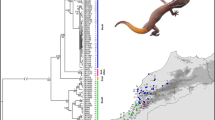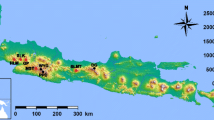Phylogenetic relationships within Hylobatidae are controversial. Numerous studies based on molecular, morphological and behavioral characteristics have provided conflicting results. I reanalyzed published cytochrome b gene sequence data to provide a new estimate of gibbon phylogeny. My results indicate that Nomascus, Symphalangus and Hoolock are successively more closely related to Hylobates. Molecular clock analyses provide estimates of divergence times within Hylobatidae, indicating that the radiation dates to ca. 10.5 million years ago. Scientists have little understanding of the biogeographic history of gibbons, largely because of a sparse fossil record. I combined the estimate of gibbon phylogeny with distribution data in a dispersal-vicariance analysis and present a new scenario for the pattern and timing of gibbon radiation.




Similar content being viewed by others
REFERENCES
Brandon-Jones, D., Eudey, A. A., Geissmann, T., Groves, C. P., Melnick, D. J., Morales, J. C., Shekelle, M., and Stewart, C. B. (2004). Asian primate classification. Int. J. Primatol. 25: 97–164.
Chatterjee, H. J. (2001). Phylogeny and Biogeography of Gibbons, Genus Hylobates. PhD Thesis, University of London.
Chivers, D. J. (1977). The lesser apes. In Prince Rainier III of Monaco Bourne, G. H. (eds.), Primate Conservation. Academic Press, New York, pp. 539–598.
Creel, N., and Preuschoft, H. (1984). Systematics of the lesser apes: A quantitative taxonomic analysis of craniometric and other variables. In Preuschoft, H., Chivers, D. J., Brockelman, W. Y., and Creel, N. (eds.), The Lesser Apes. Evolutionary and Behavioural Biology. Edinburgh University Press, Edinburgh, pp. 562–613.
Felsenstein, J. (1995). PHYLIP: Phylogeny Inference Package Version 3.57c. University of Washington, Seattle, WA.
Garza, J. C., and Woodruff, D. S. (1992). A phylogenetic study of the gibbons (Hylobates) using DNA obtained noninvasively from hair. Mol. Phylogenet. Evol. 1: 202–210.
Geissmann, T. (1995). Gibbon systematics and species identification. Int. Zoo News 42(8): 467–501.
Geissmann, T. (2002). Taxonomy and evolution of gibbons. In Soligo, C., Anzenberger, G., and Martin, R. D. (eds.), Anthropology and Primatology into the Third Millennium: The Centenary Congress of the Zürich Anthropological Institute (Evolutionary Anthropology Vol. 11, Suppl. 1). New York: Wiley-Liss, New York, pp. 28–31.
Goodman, M., Porter, C. A., Czelusniak, J., Page, S. L., Schneider, H., Shoshani, J., Gunnell, G., and Groves, C. P. (1998). Toward a phylogenetic classification of primates based on DNA evidence complemented by fossil evidence. Mol. Phylogenet. Evol. 9(3): 585–598.
Groves, C. P. (1972). Systematics and phylogeny of gibbons. In Rumbaugh, D. M. (ed.), Gibbon and Siamang. Vol. 1, Karger, Basel, pp. 1–89.
Haimoff, E. H., Gittins, S. P., Whitten, A. J., and Chivers, D. J. (1984). A phylogeny and classification of gibbons based on morphology and ethology. In Preuschoft, H., Chivers, D. J., Brockelman, W. Y., and Creel, N. (eds.), The Lesser Apes. Evolutionary and Behavioural Biology. Edinburgh University Press, Edinburgh, pp. 614–632.
Hall, L. M., Jones, D., and Wood, B. (1996). Evolutionary relationships between gibbon subgenera inferred from DNA sequence data. Biochem. Soc. Trans. 24, 416.
Hall, L. M., Jones, D., and Wood, B. (1998). Evolution of the gibbon subgenera inferred from cytochrome b DNA sequence data. Mol. Phylogenet. Evol. 10(3): 281–286.
Hall, R. (1998). The plate tectonics of Cenozoic SE Asia and the distribution of land and sea. In Hall, R., and Holloway, J. D. (eds.), Biogeography and Geological Evolution of SE Asia. Backbuys, Leiden, pp. 99–131.
Hayashi, S., Hayasaka, K., Takenaka, O., and Horai, S. (1995). Molecular phylogeny of gibbons inferred from mitochondrial DNA sequences: Preliminary report. J. Mol. Evol. 41: 359–365.
Heaney, L. R. (1991). A synopsis of climatic and vegetational change in Southeast Asia. Climatic Change 19: 53–61.
Higgins, D. G., and Sharp, P. M. (1988). CLUSTAL: A package for performing multiple sequence alignments on a microcomputer. Gene 73: 237–244.
Jablonski, N. G. (1993a). Quaternary environments and the evolution of primates in Eurasia, with notes on two specimens of fossil Cercopithecidae from China. Folia Primatol. 60: 118–132.
Maddison, W. P., and Maddison, D. R. (1992). MacClade. Analysis of Phylogeny and Character Evolution. Version 3.0.1. MA: Sinauer Associates, Sunderland.
Morley, R. J., and Flenley, J. R. (1987). Late Cainozoic vegetational and environmental changes in the Malay Archipelago. In Whitmore, T. C. (ed.), Biogeographical Evolution of the Malay Archipelago. Oxford Monographs on Biogeography, 4. Oxford University Press, Oxford, pp. 50–59
Porter, C. A., Page, S. L., Czelusniak, J., Schneider, H., Schneider, M. P. C., Sampaio, I., and Goodman, M. (1997). Phylogeny and evolution of selected primates as determined by sequences of the ɛ-globin locus and 5′ flanking regions. Int. J. Primatol. 18(2): 261–295.
Raaum, R. L., Sterner, K. N., Noviello, C. M., Stewart, C., and Disotell, T. R. (2005). Catarrhine primate divergence dates estimated from complete mitochondrial genomes: concordance with fossil and nuclear DNA evidence. J. Hum. Evol. 48: 237–257.
Ronquist, F. (1996). DIVA Version 1.1. Computer program and manual available by anonymous FTP from Uppsala University (ftp.uu.se or ftp.systbot.uu.se).
Ronquist, F. (1997). Dispersal-vicariance analysis: A new approach to the quantification of historical biogeography. System. Biol. 46(1): 195–203.
Swofford, D. L. (1993). PAUP: Phylogenetic Analysis Using Parsimony. Version 3.1.1. Illinois Natural History Survey, Champaign, IL.
Tyler, D. E. (1993). The evolutionary history of the gibbon. In Jablonski, N. (ed.), Evolving Landscapes and Evolving Biotas of East Asia Since the Mid-Tertiary. Centre for Asian Studies, Hong Kong University, pp. 228–240.
Wu, R. K., and Pan, Y. R. (1984). A Late Miocene gibbon-like primate from Lufeng, Yunnan Province. Acta Anthropol. Sinica 3: 193–200.
Wu, R. K., and Pan, Y. R. (1985). Preliminary observations on the cranium of Laccopithecus robustus from Lufeng, Yunnan with reference to its phylogenetic relationship. Acta Anthropol. Sinica 4, 7–12.
Zehr, S., Ruvolo, M., Heider, J., and Mootnick, A. (1996). Gibbon phylogeny inferred from mitochondrial DNA sequences. Am. J. Phys. Anthropol. (Suppl) 22: 251.
ACKNOWLEDGMENTS
I thank Adrian Lister for his constructive comments on early versions of the manuscript and several useful discussions. I also thank Marcello Ruta, Leslie Aiello, and Mark Thomas. I especially thank Ian Barnes for comments on the manuscript.
Author information
Authors and Affiliations
Corresponding author
Rights and permissions
About this article
Cite this article
Chatterjee, H.J. Phylogeny and Biogeography of Gibbons: A Dispersal-Vicariance Analysis. Int J Primatol 27, 699–712 (2006). https://doi.org/10.1007/s10764-006-9044-1
Received:
Accepted:
Published:
Issue Date:
DOI: https://doi.org/10.1007/s10764-006-9044-1




